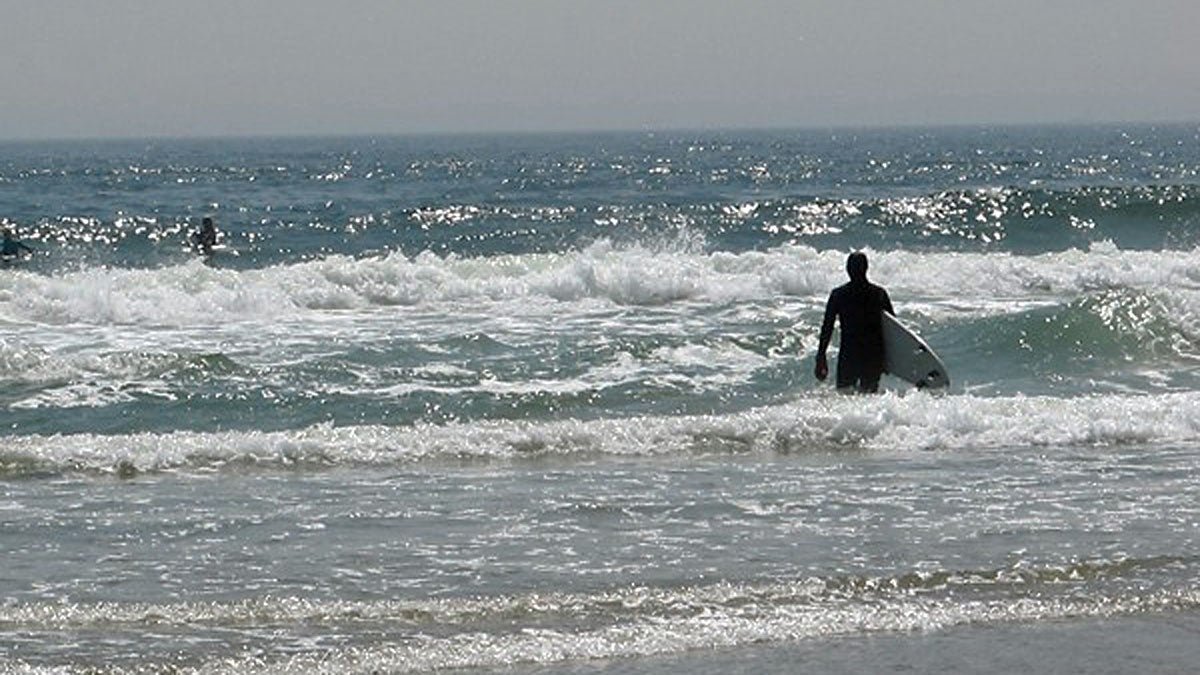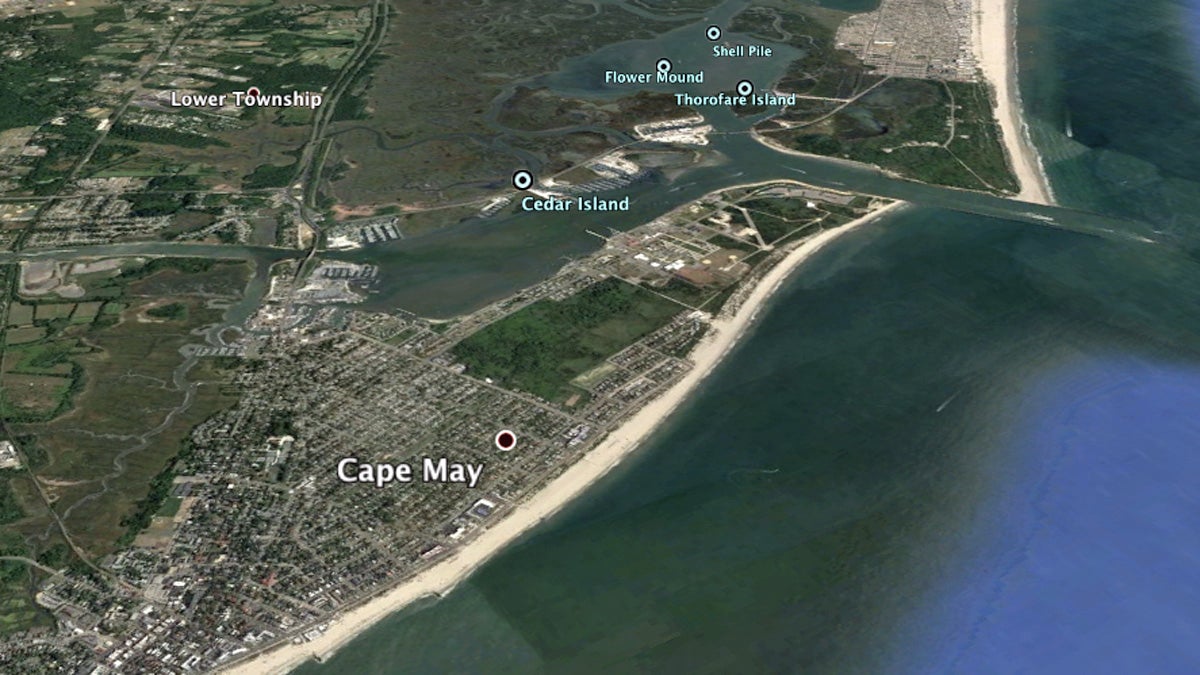Why Cape May’s beaches need a makeover

(Phil Gregory/WHYY file photo)
The beaches in Cape May — at the tip of New Jersey’s tide-washed peninsula — are pretty and clean. They’re dotted with pastel cabanas and frequented by migrating shore birds. And they’re guarded by a diligent lifeguard patrol, one that hasn’t had a single drowning in its 106-year history. By all vacation standards, the beaches here are an excellent place to plant a canvas chair or take in a sunset.
But recently, Cape May’s beaches have come under fire. Beneath the breaking waves, critics say, is a seafloor that drops off too severely, creating dangerous conditions for surfers and bodysurfers.
I love Cape May so much, I moved here six years ago. But I understand the concern. In the nearly two decades I’ve been a surfer, I’ve paddled into many waves, from Desperations break in Fiji (which lives up to its name) to Snapper Rocks in Australia. I’ve suffered a concussion in the water, and I’ve wiped out into beds of coral reef and sea urchin. But it’s the swell in Cape May that has spooked me out of the ocean and left me driving up the parkway in search of gentler conditions. It’s not wave size that’s the problem — it’s that these waves break into shallow water, sometimes ankle deep, heightening the risk of cervical spine injury.
Addressing the problem has been tricky for the city, a place whose economy depends on not scaring tourists away. But with a new mayor who ran on a platform of beach safety — things could be changing for Cape May’s seascape.

The scoop on the slope
During World War II, the Army Corp of Engineers dug a canal between Cape May’s harbor and the Delaware Bay in order to shield American ships from attack by German U-boats. (This is what made Cape May an island.) During the process, to protect the canal, the agency extended existing stone wall jetties 4,500 feet into the ocean. While they served their purpose, these structures trapped and prevented sand from depositing naturally in Cape May. In other words, they starved the beaches. Over the years, the sand here depleted so much, sunbathers were forced onto large boulders that had been placed in the dunes in the 1940s in order to protect coastal properties from ocean waves — not exactly a vacationer’s dream.
In 1991, a directive from President George H Bush allowed the Army Corps of Engineer to propose a solution via a long-term nourishment plan. That year, the agency pumped an initial 900,000 cubic yards of sand onto Cape May’s main beach, with plans to replenish every two years for 50 years thereafter. We’re now half-way through that deal.
At first glance, this strategy appears to be an economic godsend — there’s enough sand to accommodate hordes of lotioned beachgoers every season. But, some experts believe, it’s this bi-yearly beach fill that has reshaped the seafloor and led to a heavier, more dangerous shorebreak. Others contend the beach profile is ultimately the prerogative of mother nature — studies show larger grains of sand equate to steeper slopes.
Either way, exacerbating the problem is man-made climate change. As sea levels rise due to global warming, shorefaces along developed coasts become more abrupt.
“Since Cape May is among the nation’s first developed coasts, the changes there have added up over a long time and have resulted in a very steep beach,” said Kenneth J Lacovara, PhD, Dean of the School of Earth & Environment at Rowan University. “Sea level will be rising for the foreseeable geological future, so this problem is not going away.”
But — at least until there’s enough political will behind solving climate change — residents and tourists want to know if it’s possible to treat the symptoms. We’re already altering Cape May’s beaches via sand fills. Imagine if we could manipulate the surfzone in the process.
The push for change
In 2001, while surfing at Cape May’s Poverty Beach during Hurricane Alberto, Chad deSatnick landed headfirst in three inches of water, shattering cervical nerves c6 and c7. While it was unclear at first whether deSatnick would walk again, he did recover. And, three years after the incident and resulting rehabilitation, he partnered with retired fire chief Jerry Inderwies and retired beach lieutenant Harry Back in launching a beach safety campaign and conducting classroom outreach in local schools. By 2009, deSatnick succeeded in convincing the city to distribute Cape May-specific safety brochures with every beach tag sold. Signs warning of heavy shorebreak have also been erected at every beach entrance, and beach safety videos filmed by the beach patrol are accessible on the city’s website.
“But ultimately, the profile of the beach is what needs to be fixed,” deSatnick said, adding that this point has historically fallen on deaf ears. “At city council meetings over the years, I’ve purposely been given misinformation or told one thing when, in fact, it’s the other.”
Fifteen months ago, the beach safety torch was picked up by deSatnick’s father, Dennis, who felt reinvigorated by the cause after 17-year-old Archer Senft broke his neck while diving into the ocean at Cape May in August of 2015. The teenager is now paralyzed from the neck down.
“This opened my wound again, made me remember that my son was one of the lucky ones,” the senior deSatnick said. “But it was always a fight at the podium during city council meetings. It was as though city officials didn’t feel like they needed to answer you. They hoped you’d just give your spiel and go away.”
The Cape May administration in question, helmed by Mayor Edward Mahaney from 2009 through December of 2016, did host a three-hour beach replenishment and safety meeting last August in which the public had opportunity to ask questions of an expert panel that included Stewart Farrell, PhD., Director of Stockton University’s Coastal Research Defense Center. He presented a report from the United States Lifesaving Association indicating that, of the 1.1 million people who visited Cape May beaches in 2015, only 211 experienced surf zone injuries — not exactly an outlier of a statistic. But the city’s beach safety advocates say this number is misleading — it only takes into account injuries that happen during in-season hours while lifeguards are on duty. As writer Emily Leaman pointed out in an article for Philadelphia magazine last fall, Cape May averages the same number of in-the-water medical emergencies as Ocean City, but has three times fewer beachgoers.
When pressed by concerned attendees, Army Corp representatives summed up the dilemma this way: We can put sand wherever you want it, but we can’t make it stay that way.
“We have made changes to flatten our construction slope and we’ve monitored those changes,” said Randy Wise, coastal engineer for the USACE. “And as we’ve presented, we’ve seen very rapidly — within a month — it goes back to a natural shape.”
Representatives from Mott MacDonald engineering firm, commissioned by Mahaney’s administration to study this issue in 2015, would agree that any solution requires maintenance. They proposed an annual, pre-summer leveling-out project worth $1 million. The money was put into the city’s municipal budget for 2016, then taken out.
The fix
In November, Chuck Lear ousted Mahaney as Mayor of Cape May. One of his first moves in office in January was to establish a Beach Safety Advisory Committee that Dennis deSatnick will chair.
One of the group’s goals will be to gather more extensive data concerning in-the-water injuries, which will involve liaising with regional hospitals. They will also look into expanding the city’s education program via classroom outreach and technology — in the near future, beachgoers could receive safety information on their devices.
As for possibly adjusting the beach’s profile, the group will reach out to Congressman Frank LoBiondo as well as New Jersey Senators Cory Booker and Robert Menendez in order to generate political will for a survey of Cape May’s beaches to determine whether the Army Corp can somehow alter their project templates — ie, where and how they dump the sand — to better ensure beach safety.
In other words: exhaust every possible avenue.
“Research might conclude there is nothing we can do to alleviate this condition,” Lear said. “But I’d rather put resources into it than assume it can’t be changed.”
If all else fails, south Jersey’s budding entrepreneurs should take heed: There may be a market for surf helmets in Cape May next summer.
WHYY is your source for fact-based, in-depth journalism and information. As a nonprofit organization, we rely on financial support from readers like you. Please give today.




